Have you ever wondered what makes modern buildings not only stand taller but also greener and more sustainable? Cross-Laminated Timber (CLT), a revolutionary building material, is transforming the construction landscape by offering an eco-friendly alternative to traditional building materials. In this introduction, we’ll explore how CLT emerged as a key player in contemporary architecture and construction, setting the stage for a greener and more resilient future.
CLT has been making waves in the construction industry for its remarkable properties and the advantages it offers over conventional materials like steel and concrete. It’s not just about building structures; it’s about redefining the very ethos of architectural design with sustainability at its core. As we delve deeper into the benefits of Cross-Laminated Timber, we’ll uncover why it’s considered a game-changer in building more sustainable and aesthetically pleasing environments.
What is Cross-Laminated Timber?
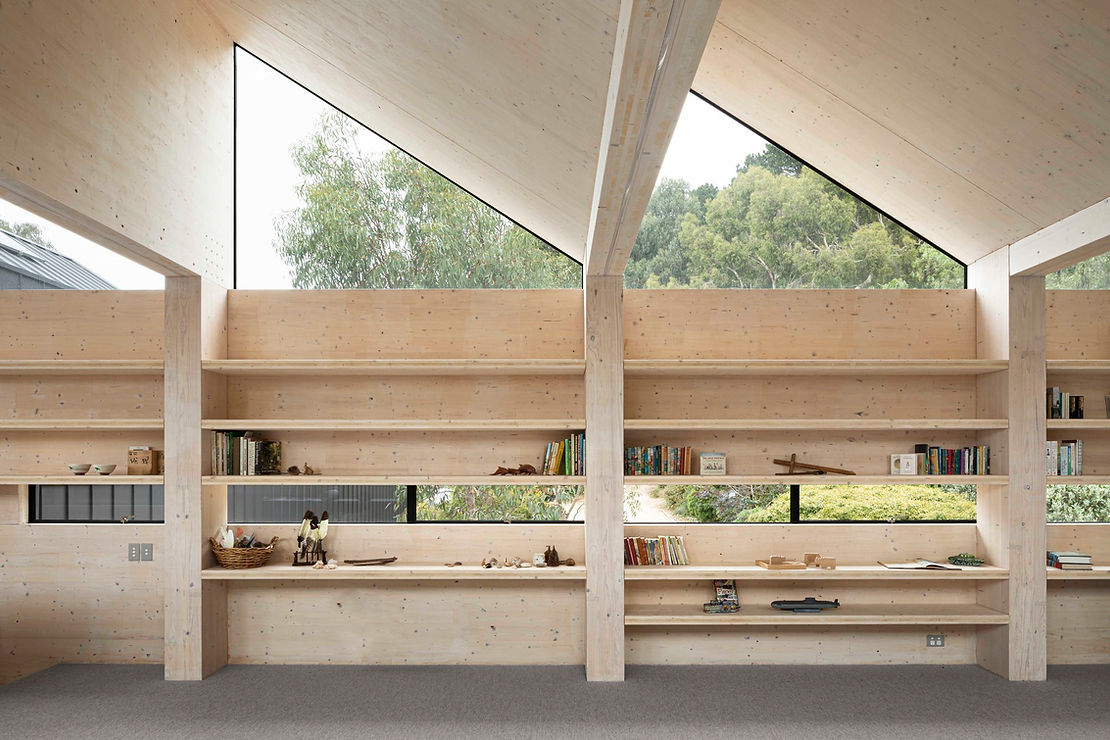
Cross-Laminated Timber (CLT) is an engineered wood product that is quickly becoming a cornerstone in modern sustainable architecture. It is made by gluing layers of solid-sawn lumber together, each layer oriented perpendicular to the previous, creating panels that are exceptionally strong and stable. This section will delve into the definition and the detailed manufacturing process of CLT, highlighting its comparison with traditional building materials.
Manufacturing Process of CLT
The process begins with sourcing sustainably harvested wood, primarily softwood species such as spruce, pine, or fir. These timbers are then cut into boards, which are kiln-dried to reduce moisture content, ensuring the wood does not warp or shrink after processing. The boards are sorted for quality, and imperfections are removed. They are then layered in perpendicular stacks and bonded together under pressure using eco-friendly adhesives. The resulting panels can vary in size, typically up to a few meters in width and length, and can be tailored to specific construction needs.
Comparison with Traditional Materials
When compared to traditional construction materials like concrete and steel, CLT offers several advantages that make it a more sustainable and versatile option. The production of CLT generates less CO2, uses less energy, and the wood itself is a renewable resource that acts as a carbon sink, sequestering carbon dioxide from the atmosphere throughout its lifecycle. Structurally, CLT panels provide comparable strength and durability to concrete and steel but are significantly lighter, which can reduce foundation requirements and overall construction costs.
CLT’s ability to be prefabricated in factory settings not only improves the precision and quality of construction elements but also significantly reduces waste and onsite construction time. This manufacturing efficiency, combined with the material’s natural insulation properties, makes CLT a compelling choice for environmentally conscious builders and architects.
Benefits of Cross-Laminated Timber
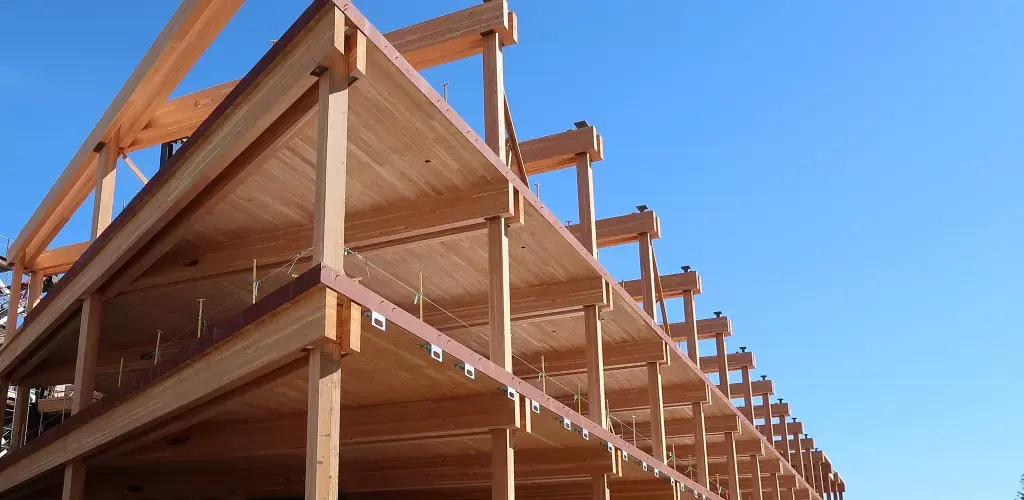
Cross-Laminated Timber offers a multitude of benefits that make it an attractive option for various construction projects, ranging from residential buildings to large commercial structures. This section highlights the key benefits of CLT, including its environmental impact, economic advantages, durability and strength, and aesthetic versatility.
Environmental Impact
One of the standout advantages of using Cross-Laminated Timber in construction is its environmental sustainability. Wood is a renewable resource, and the trees used to manufacture CLT panels absorb CO2 from the atmosphere, reducing the overall carbon footprint. Furthermore, the production process of CLT requires less energy compared to conventional construction materials like steel or concrete, resulting in lower greenhouse gas emissions. CLT structures can also be disassembled and the materials reused or recycled, contributing to a circular economy.
Economic Benefits
Economically, CLT proves to be cost-effective over the long term. Its lightweight nature reduces logistical costs as it is easier to transport and handle on site compared to heavier materials like steel. The prefabrication of CLT panels allows for quicker construction times, significantly cutting down labor costs and reducing the overall project timeline. These factors combined make CLT a financially viable solution for many developers and investors.
Durability and Strength
Despite its lightweight, CLT exhibits exceptional strength and durability. It can support heavy loads and is suitable for use in both walls and floors, making it a versatile choice for many types of structures. Additionally, CLT’s dimensional stability and resistance to shrinkage and swelling enhance its longevity and reduce maintenance costs over the life of the building.
Aesthetic Versatility
CLT also offers great aesthetic flexibility, which can enhance the design and appeal of buildings. It can be left exposed to showcase its natural wood beauty, contributing to warm and inviting interior spaces. Architects and designers value CLT for its ability to blend seamlessly with other materials, providing endless creative possibilities for both exterior facades and interior designs.
CLT is not only a practical choice for sustainable construction but also a beautiful one, aligning the functional needs of a building with modern aesthetic values. This synergy between form and function is what makes Cross-Laminated Timber a revolutionary material in the 21st century.
Challenges and Solutions
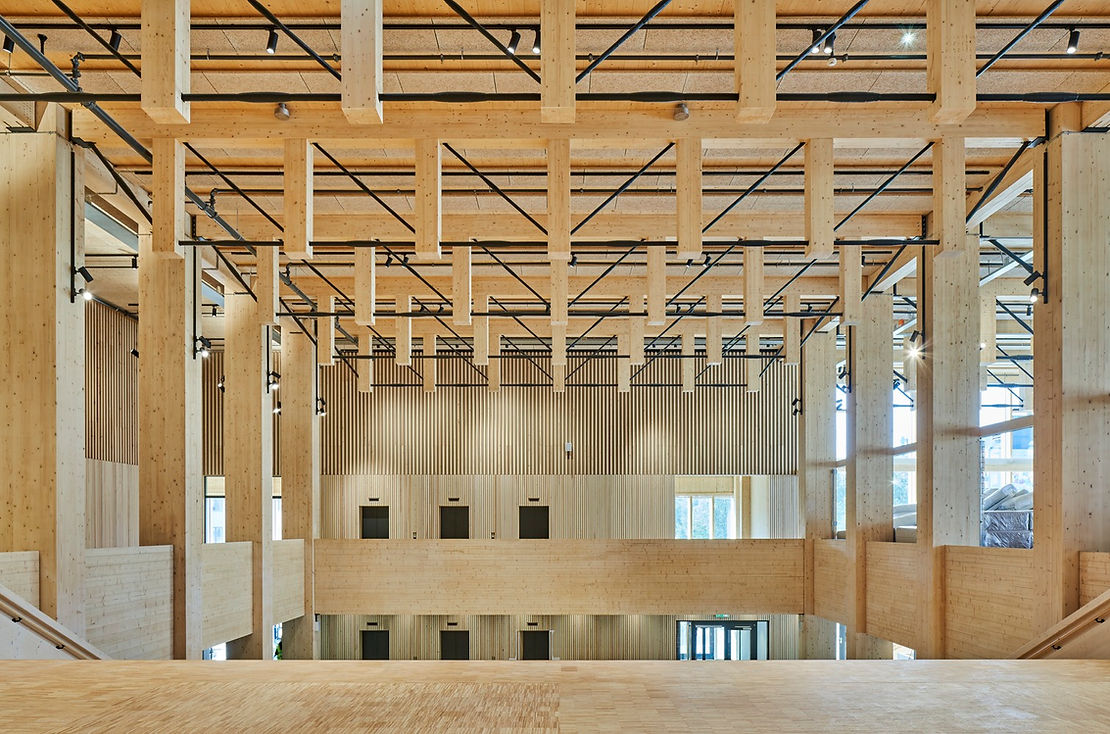
While Cross-Laminated Timber offers many benefits, like all building materials, it also faces certain challenges. Addressing these effectively is key to maximizing the potential of CLT in construction. This section discusses the main challenges associated with CLT, such as fire resistance, moisture management, and engineering complexities, and explores the innovative solutions being implemented.
Fire Resistance
One of the common concerns about using wood in construction is its performance under fire conditions. Unlike traditional materials such as concrete or steel, wood is inherently combustible. However, CLT has a unique ability to resist fire due to its thick cross-sectional area. When exposed to fire, the outer layers of CLT char, which naturally insulates and protects the inner layers from burning. This charring process slows down the rate of combustion, allowing CLT structures to maintain their integrity longer during a fire. Engineers and architects are continuously working on enhancing the fire-resistant properties of CLT through treatments and by integrating fire-resistant materials into the design.
Moisture and the Elements
Another challenge for CLT is its vulnerability to moisture, which can lead to issues like rot or mold if not properly managed. To counteract this, CLT panels are often treated with moisture-resistant coatings and are designed in a way that prevents water accumulation. Additionally, proper design and maintenance are crucial to ensure that moisture does not penetrate the building envelope. Innovations in construction techniques and barrier materials are also helping to improve the moisture resistance of CLT-based structures.
Engineering and Design Challenges
The use of CLT also presents certain engineering and design challenges, particularly in terms of connections and load distribution. CLT panels must be carefully engineered to ensure that they can safely transfer loads and resist various forces. This often requires specialized hardware and joinery techniques that can differ significantly from those used in traditional construction. To address these issues, the industry is investing in research and development to create new engineering solutions and to refine the design processes for CLT structures, making them both safe and efficient.
Despite these challenges, the ongoing advancements in technology and building practices are helping to overcome the barriers to CLT’s widespread adoption. As more is understood about how to effectively integrate and utilise CLT in construction, its role in building sustainable, efficient, and aesthetically pleasing structures is expected to grow significantly.
Case Studies: CLT in Action
To truly appreciate the capabilities and versatility of Cross-Laminated Timber, examining real-world applications is invaluable. This section explores several case studies where CLT has been effectively used in different types of construction projects, from residential buildings to large-scale commercial and institutional structures. These examples highlight the practical benefits and innovative uses of CLT across the globe.
Residential Projects
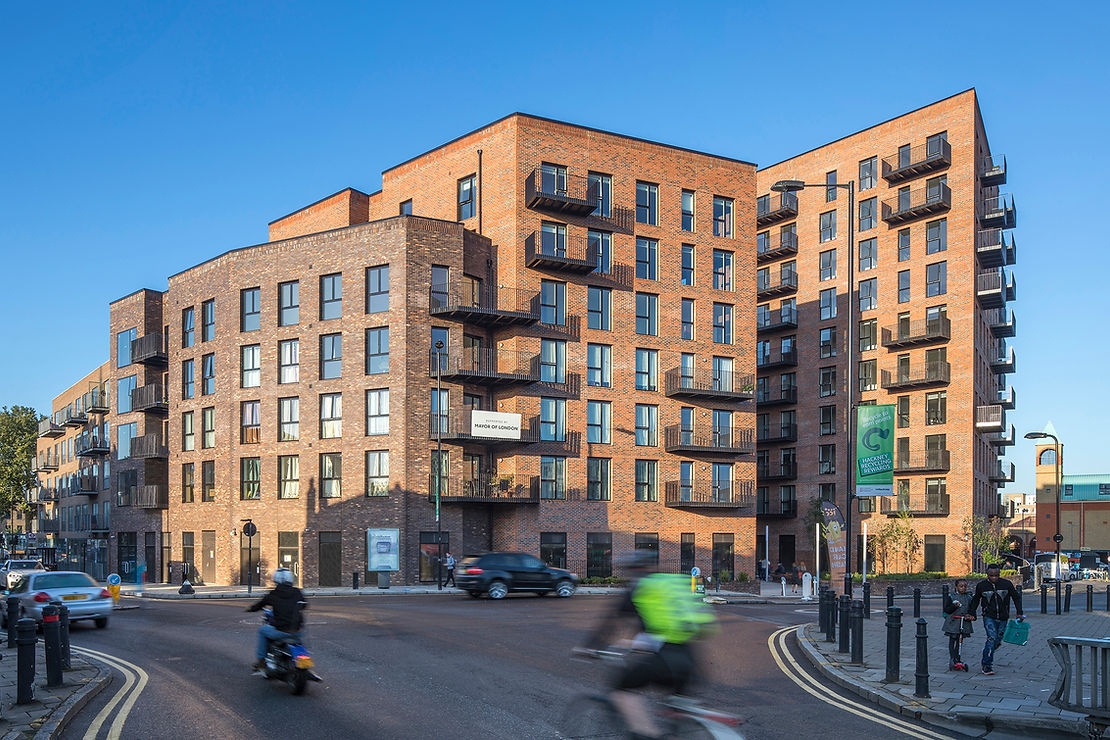
In the residential sector, CLT is increasingly favored for its rapid construction and sustainability features. One notable example is a multi-story residential building in London, known as Dalston Lane (pictured above). This project utilized CLT for its entire structure, making it one of the largest CLT projects in the world. The use of CLT not only sped up the construction process but also significantly reduced the building’s carbon footprint. Residents benefit from the aesthetic appeal of exposed wood interiors along with the building’s excellent thermal and acoustic properties.
Commercial and Institutional Buildings
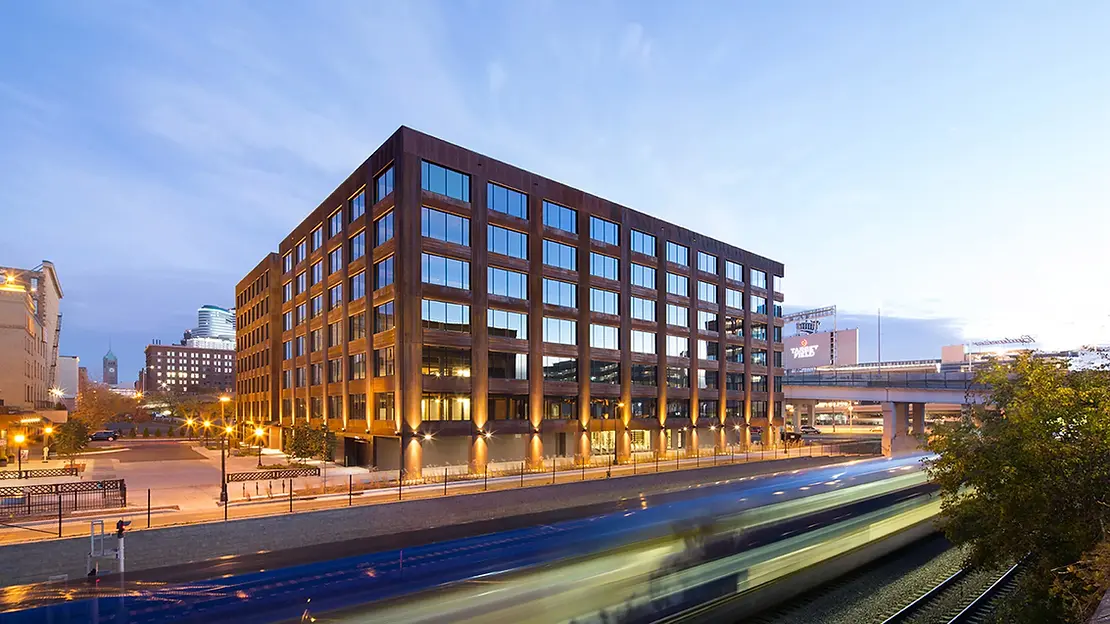
CLT is also making strides in commercial and institutional architecture. The T3 Building in Minneapolis, USA (pictured above), stands as a testament to this trend. This seven-story office building, constructed entirely from CLT, showcases the material’s strength and potential for large-scale developments. The T3 Building emphasizes sustainability, as CLT’s carbon-sequestering properties align with the green building goals of many corporations today.
Another exemplary project is the Brock Commons Tallwood House at the University of British Columbia, Canada. This 18-story student residence is one of the tallest wood buildings in the world and was completed in less than 70 days of floor construction. The project demonstrates how CLT can be used in high-rise buildings, challenging the traditional skyscraper construction paradigm.
Innovations and Mixed-Use Developments
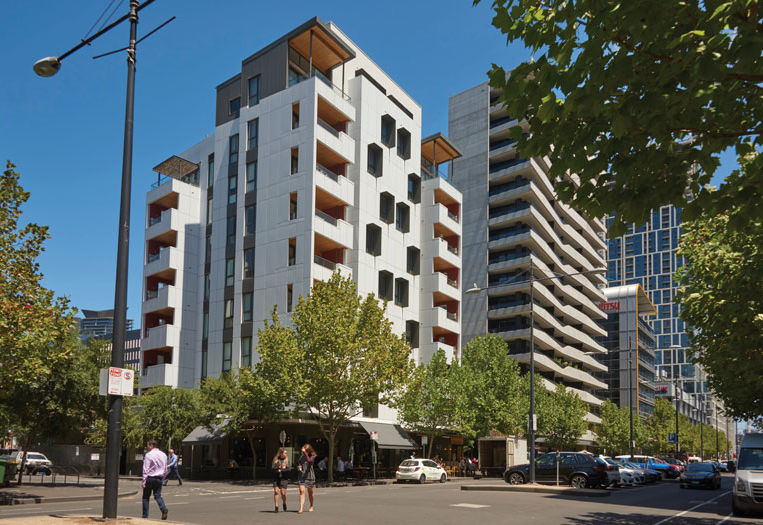
CLT’s adaptability is also evident in mixed-use developments, which combine residential, commercial, and sometimes industrial spaces. For example, the Forté building in Melbourne, Australia (pictured above), was one of the first to use CLT in a mixed-use setting, combining residential apartments above retail spaces. The project not only delivered quicker construction times and reduced labor costs but also enhanced energy efficiency and occupant comfort.
These case studies demonstrate the broad range of applications for CLT and its potential to revolutionize the building industry. By showcasing successful projects, they provide valuable insights into the practical benefits and innovative solutions associated with this sustainable building material.
Innovations in CLT
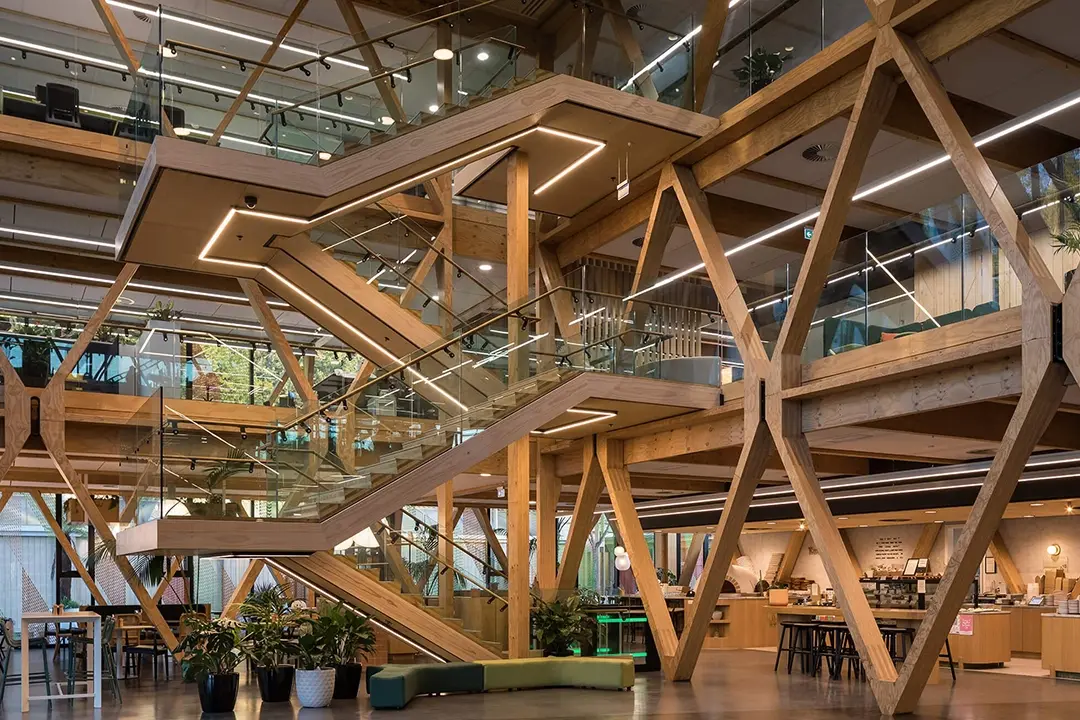
The ongoing evolution of Cross-Laminated Timber technology is pivotal in broadening its application across the construction industry. This section explores current innovations and technological advancements that enhance the performance and appeal of CLT, facilitating its integration into more complex and varied building projects.
Technological Advancements
One of the most significant advancements in the field of CLT is the development of hybrid structures. These are constructions that combine CLT with other materials such as steel or concrete to capitalize on the strengths of each material. For example, hybrid CLT and steel buildings benefit from the lightweight, sustainable nature of wood and the structural strength and flexibility of steel. This combination allows for larger spans and more versatile architectural designs that were previously difficult to achieve with CLT alone.
Another innovation involves the improvement of connection systems for CLT panels. Traditional joining methods can be cumbersome and visually intrusive, so new, more integrated solutions have been developed. These include hidden fasteners and advanced adhesive technologies that not only enhance the structural integrity of CLT constructions but also maintain the aesthetic quality of wood surfaces.
Hybrid Structures
Hybrid structural designs are not just a technical improvement; they represent a shift towards more resilient and adaptable building practices. For instance, in areas prone to earthquakes, CLT-steel hybrid structures offer improved seismic performance, combining the flexibility of steel with the mass and damping properties of wood. This approach significantly enhances safety and durability, making CLT a more appealing choice in regions with challenging environmental conditions.
Global Collaborations and Research
The growth of CLT technology is also supported by global collaborations among researchers, architects, and builders. These partnerships focus on pushing the boundaries of what’s possible with wood construction, from exploring new types of wood treatments to enhance durability and fire resistance, to developing modular CLT systems that can be rapidly assembled in disaster relief scenarios.
These innovations are making CLT not just a viable option, but a preferred choice in many contexts, paving the way for its future as a leading material in sustainable construction.
Global Market Trends
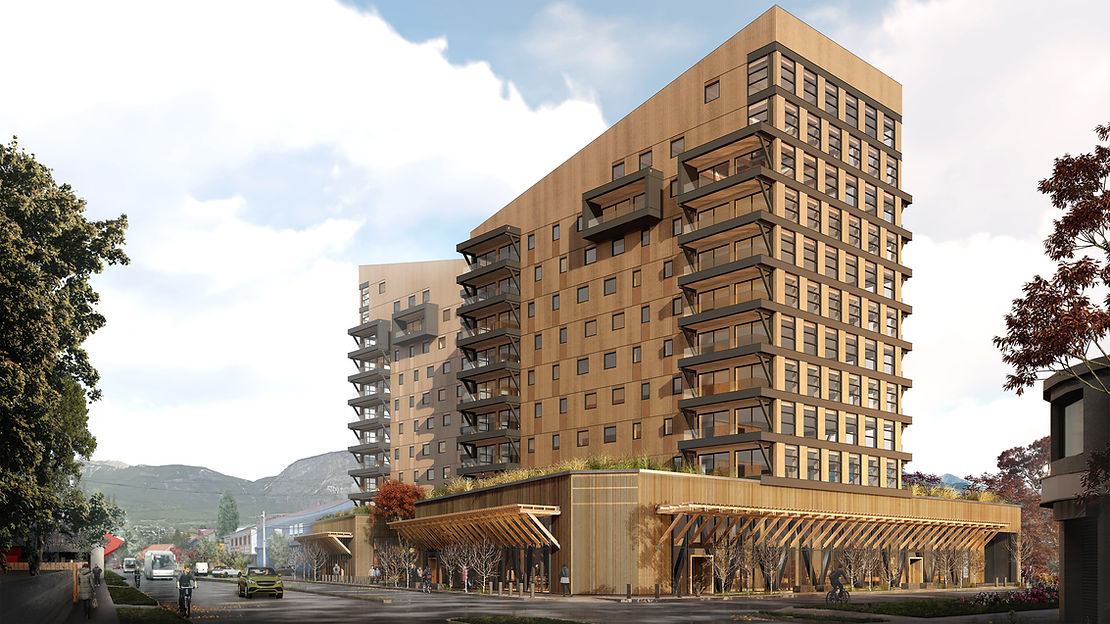
The adoption of Cross-Laminated Timber is experiencing varied trends across different regions, influenced by local policies, sustainability goals, and architectural traditions. This section discusses how CLT is making inroads in key markets around the world, identifying the drivers and challenges of its global uptake.
Europe’s Leadership in CLT
Europe stands out as a pioneer in the CLT market, with countries like Austria, Germany, and Switzerland leading in both production and use. European architects and builders have embraced CLT for its sustainability credentials and its alignment with stringent EU regulations on carbon emissions. The widespread acceptance of CLT in Europe is also driven by government incentives that promote green building practices and a robust forestry industry that supplies high-quality timber.
North America’s Growing Adoption
In North America, interest in CLT is growing rapidly, particularly in the United States and Canada. The adoption is spurred by the urban renewal initiatives and the increasing demand for sustainable urban housing solutions. For example, the TallWood Design Institute in Oregon is actively promoting research and development in wood-based construction, including CLT, helping to educate builders and policymakers about its benefits. Additionally, recent changes to the International Building Code (IBC) that allow taller wood-based structures have opened new opportunities for CLT in commercial and residential high-rise buildings.
Asia-Pacific’s Emerging Interest
The Asia-Pacific region is beginning to explore the potential of CLT, particularly in countries like Japan and Australia, where seismic activity and sustainability are major concerns. Japan, for instance, has incorporated CLT into its building practices as part of its disaster resilience planning, using the material’s lightweight and shock-absorbent properties to construct buildings that can better withstand earthquakes. Meanwhile, Australia is focusing on CLT as a tool for combatting urban heat islands and reducing HVAC energy costs in its dense city environments.
Challenges to Adoption
Despite its many benefits, the adoption of CLT faces challenges, primarily related to the existing building codes that are not yet fully adapted to incorporate wood-based multi-story constructions. There is also a need for more skilled labor trained in CLT construction techniques, and the initial cost and availability of materials can be barriers in regions without local production facilities.
Overall, the global market for CLT is expanding as more regions recognize its potential benefits. This trend is supported by technological advancements, regulatory changes, and a growing commitment to sustainability in the construction industry.
Sustainable Practices in CLT Production
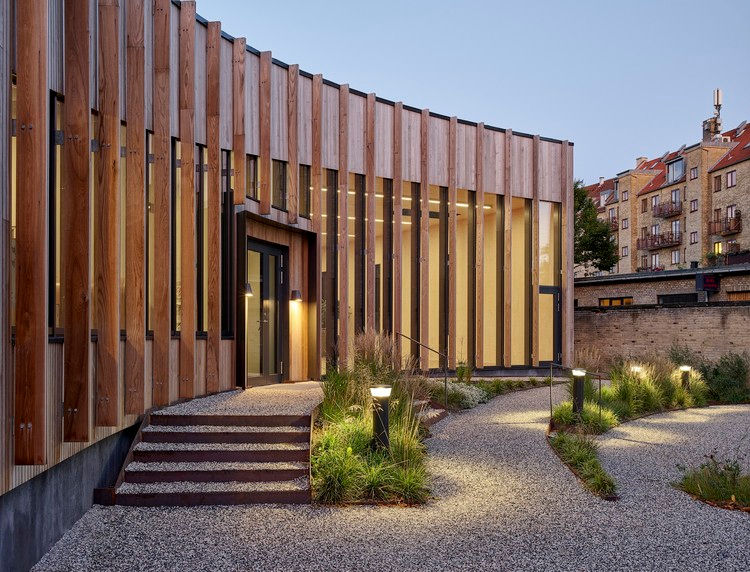
As the popularity of Cross-Laminated Timber grows due to its significant benefits, there is an increasing focus on ensuring that its production processes remain sustainable. This section examines the sustainable practices that are integral to the manufacturing of CLT, emphasizing how these practices reinforce the environmental benefits of Cross-Laminated Timber and contribute to its reputation as a green building material.
Sourcing and Certification
The sustainability of CLT begins with responsible sourcing of wood. Manufacturers prioritize timber from certified forests that are managed for long-term viability. Certifications such as FSC (Forest Stewardship Council) and PEFC (Programme for the Endorsement of Forest Certification) are important markers that ensure the wood used in CLT production comes from forests that adhere to strict environmental and social standards. These certifications help in maintaining biodiversity, protecting water resources, and supporting the rights of indigenous populations.
Minimising Waste and Energy Use
The production process of CLT itself is designed to minimize waste. Offcuts and sawdust generated during the manufacturing process are often repurposed for other products, such as biofuel or particle board, ensuring that very little goes to waste. Additionally, the energy used in the production of CLT is considerably lower than that required for manufacturing more traditional construction materials like steel or concrete, further enhancing the environmental benefits of Cross-Laminated Timber.
Lifecycle Analysis and Recycling
Lifecycle analysis (LCA) is increasingly used to assess the environmental impact of CLT from cradle to grave. LCA studies consider every aspect of the product’s life, from the extraction of raw materials through to its end of life. This comprehensive view helps manufacturers and builders understand and reduce the environmental impacts associated with the use of CLT. Moreover, CLT’s capacity for recycling and reuse at the end of its life adds to its environmental credentials, reducing the need for disposal in landfills and lowering the overall environmental footprint.
Carbon Sequestration
Another key sustainable practice linked to the benefits of Cross-Laminated Timber is its ability to sequester carbon. Wood naturally captures and stores carbon dioxide throughout its growth cycle. When used in construction, this carbon is effectively locked within the CLT for the lifespan of the building, which can be several decades, thus contributing to reduced atmospheric CO2 levels. This characteristic is particularly valuable in the fight against climate change, making CLT an attractive option for eco-conscious projects.
These sustainable practices not only support the environmental benefits of Cross-Laminated Timber but also enhance its appeal to architects, builders, and developers looking for eco-friendly construction materials. By maintaining strong sustainability credentials, the use of CLT aligns with global efforts to reduce carbon emissions and promote renewable resources.
Conclusion
As we’ve explored the numerous benefits of Cross-Laminated Timber, it’s clear that CLT is more than just a building material; it represents a shift towards more sustainable, efficient, and innovative construction practices. The benefits of Cross-Laminated Timber, from its environmental sustainability to its economic and structural advantages, position it as a key player in the future of building.
Summary of Benefits
The environmental benefits of Cross-Laminated Timber are undeniable. By utilizing a renewable resource that sequesters carbon, CLT contributes to reducing the overall carbon footprint of construction projects. Its manufacturing process, which emphasizes energy efficiency and minimal waste, aligns with the goals of sustainable development. Economically, the speed and efficiency of CLT construction reduce labor and material costs, making projects more affordable and feasible within shorter timelines. Structurally, the strength and versatility of CLT allow for innovations in design and architecture that were previously unattainable with traditional materials.
Transformative Impact in Construction
The transformative impact of Cross-Laminated Timber in the construction industry is already evident in the numerous buildings and projects around the world that utilize this material. As building codes evolve and awareness of CLT’s benefits grows, we can expect to see even broader adoption. The shift towards more sustainable materials like CLT is crucial in addressing global challenges such as climate change and urbanization. By integrating CLT into more projects, the construction industry can significantly contribute to creating greener, more sustainable urban environments.
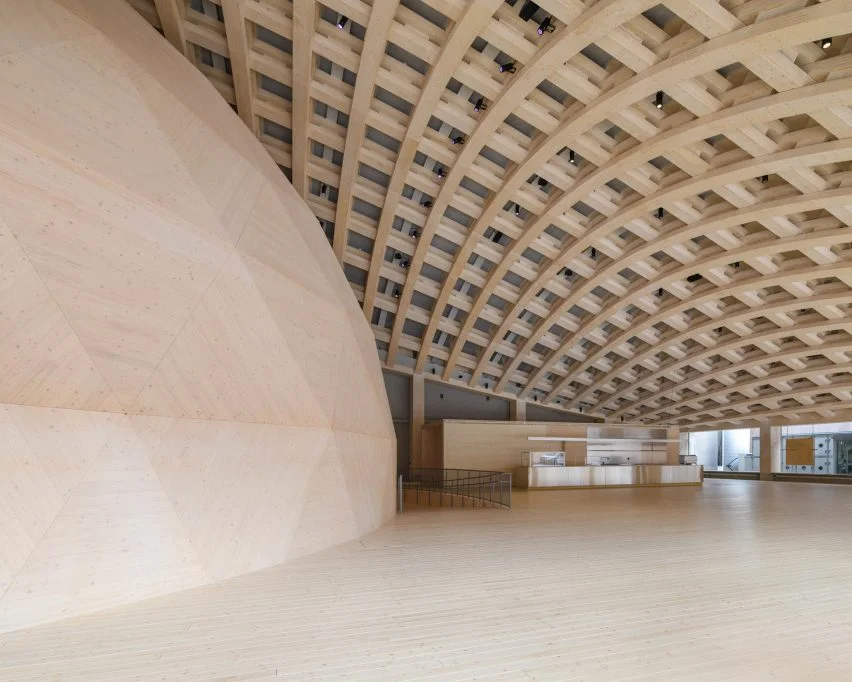
Recent Posts
15 Floor Plan Graphic Styles That Will Elevate Your Presentation Game
The Role of Shadows in Architectural Storytelling
When Furniture Becomes Architecture: Blurring the Line